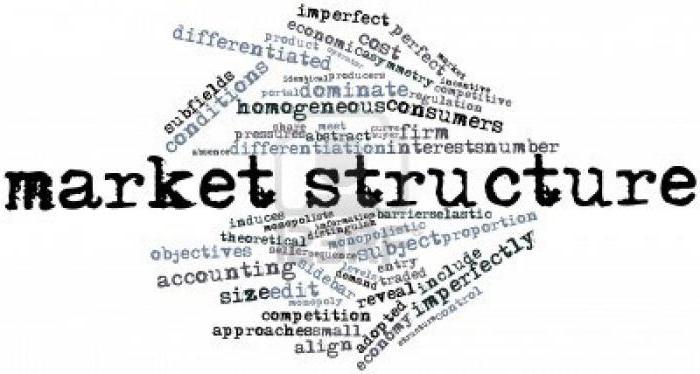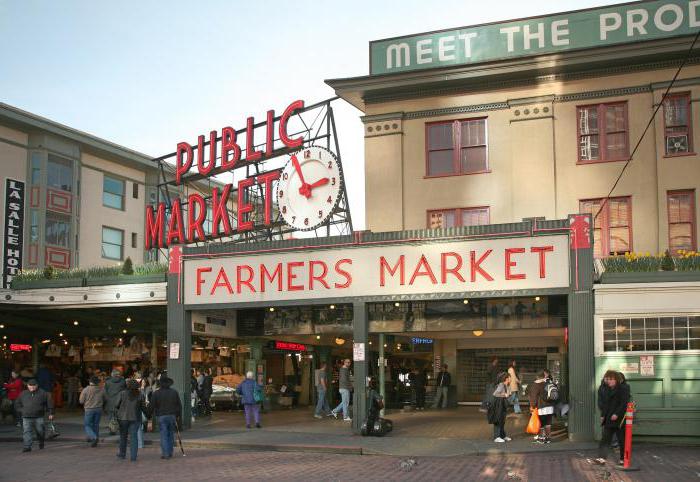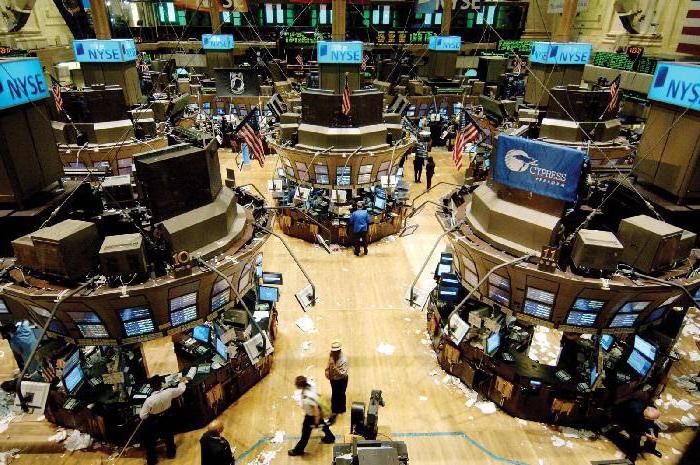The market is one of the forms of sale of products of commodity production. Today, the definitions of this term, as well as economic theories associated with it, are great. However, the assertion that the market is one of the ways of interaction between the seller of the goods and his buyer will be true in any case.

The nature and conditions of the market
The market is one of the achievements of civilization, characterizing the level of its development. Over more than 6 thousand years of its existence, the structure of markets has come a long way - from simple to complex forms. In the first case, this term refers only to the method of interaction between the selling and buying parties. In the second, broader, structure and market functions understood as a set of economic relations arising in the process of exchange of goods and services.
The main condition under which the market structure is formed is the division of social labor. It is at this moment that an employee of a certain field of activity gets the opportunity to take advantage of the labor of workers in other fields in exchange for certain material values.
Specialization is another necessary condition for the development of the market, not only between different industries, but also within the same enterprise at certain stages of production.
Natural limitation, that is, a person’s ability to produce only a certain amount of goods, also refers to the conditions of market development, however, like the economic isolation of producers of goods. The latter should be understood as the freedom to dispose of the results of one's production activities. It is also worth noting the freedom of man to realize his interests and satisfy needs.
Subjects and objects of market relations
The subjects of market relations are parties to commodity-money relations. These are both individuals and legal entities: sellers, buyers, organizations, associations, including the state. The subjects of market relations, depending on the functions performed by them in the market, are divided into sellers and buyers. Another way to classify them is by ownership: private, public and collective (group). Today is all market entities classified into 3 groups.
1. Households - owners and suppliers of consumer goods. The funds received as a result of the transaction, such farms direct to meet their needs, and not to improve and increase production. Households are consumers of the final results of production (goods and services).
2. Business - an enterprise conducting trade in order to obtain benefits. Own business involves investing in it their own or credit funds. In the market is a supplier of goods.
3. The state in the market is represented mainly by budgetary organizations whose function is to implement state economic policy. It can also act in the face of municipal organizations - producers of goods and services.
Market objects - this is something in relation to which commodity-money relations arise: goods and services, intangible goods technical ideas, manufacturing equipment, etc.

The concept and structure of the market
The structure of markets is their internal composition, the location of its individual elements, their share in the overall market system and the interaction between them.Today, markets are classified according to many economic signs: form of ownership, structure of production, level of privatization, type of trade, etc.
In addition, the market has its own infrastructure, that is, a system of organizations whose function is to ensure its normal functioning. We will consider the main elements of infrastructure below.
- A fair is a regular market of significant scale, located in a specific place. Such events can be arranged periodically (every weekend) in order to sell a wide range of goods or seasonally - to sell certain types of goods. Today, the most common fairs are consumer goods.
- Auctions - a type of trade when the product (usually rare) goes to the buyer who offered the highest price for it. They are voluntary and compulsory (mortgage property fair).
- Exchange - the place of conclusion of transactions of sale.
- The credit system - all those who are able to lend the buyer the necessary amount of money. The central link of the credit system is banks.
- State financing - the budget of the state and the constituent entity of the Russian Federation in whose territory the given market is located.

Market functions
- Regulatory - the establishment of the necessary reproductive economic proportions of supply and demand.
- Pricing - the formation of prices for goods and services as a result of the collision of product supply and customer demand.
- Stimulating - stimulating the efficiency of the economy through market prices.
- Informing - notification of market participants about changing market conditions.
- Intermediary - a direct connection of manufacturers, sellers and buyers of the goods and services provided.
- Sanitizing - cleansing the market of non-viable and encouraging economically stable participants.
- Social - providing the state with opportunities to achieve the highest levels of social justice in the economic sphere.
The structure and functions of the market are determined by its elements: producers (sellers), consumers (buyers), competition, customer demand and supply.

Types of markets depending on the conditions of activity of market relations
Free is a market in which a large number of independent producers trade, offering the buyer uniform products. In this case, they are not able to influence the pricing policy and set limits on the price, demand and quality of the product. Free pricing formed by customer demand and supply. Goods enter the market also freely, since there are no artificial barriers created by competing manufacturers.
The monopolized structure of markets is characterized by a small number of producers of homogeneous goods whose actions are consistent with each other. Buyers in such markets, as a rule, experience a shortage of necessary product information, and also have limited access to product resources.
The regulated market is controlled not by producers of goods, but by the state through certain administrative and state penalties.
Labor market
It is the labor market that experts call the key element of the economic market system. Its function is the organization of socio-economic relations between employing organizations and wage labor. The structure of the labor market will not function without observing the conditions of emergence and existence: a legally free seller of labor (wage worker) without the necessary means of production, the buyer is the employer and they must have the same civil rights and freedoms.
The structure of the labor market implies fixing the results of transactions in contracts, which indicate: conditions and volume of work performed, salary, frequency and duration of vacations, etc.e. Today, every free citizen has the right to independently sell his wage labor and the choice of type of activity in accordance with the principles of a labor contract.
Market of services and consumer goods
The market for consumer goods and services is an economic relationship organized on the principle of cost to honey by producers and consumers in the process of organizing and buying and selling services and consumer goods. It reflects the existing supply and demand in the market.
The market of goods and services is a way of a reverse impact on production: accelerating the process of acquiring goods helps to increase the productivity of suppliers.
The structure of the service market today needs to be restructured to increase the share of production of the most modern means of labor.

Financial market
The financial market is economic relations arising in the process of buying and selling financial resources. The structure of the financial market is aimed at fulfilling the main function - transferring free cash of the population and economic entities into a single channel through securities, assets and other forms of capital.
The sellers in the financial market are banks (public and private), various pension and investment funds, insurance companies, etc.
The buyers in this case are the population, the state and various business organizations. The structure of the financial market contributes to more efficient accumulation and distribution of funds in order to provide the necessary resources for the entities of the manufacturing industry. In a broader sense, the socio-economic development of the state as a whole.
Securities Market Structure
The object of this market are bonds, assets, bills, etc., that is, everything that has a certain value in the stock market. The structure of the securities market as subjects determines all participants in emerging economic relations. These include: legal entities that issue securities for profit, various organizations that take such securities into circulation, and individuals who purchase them.








